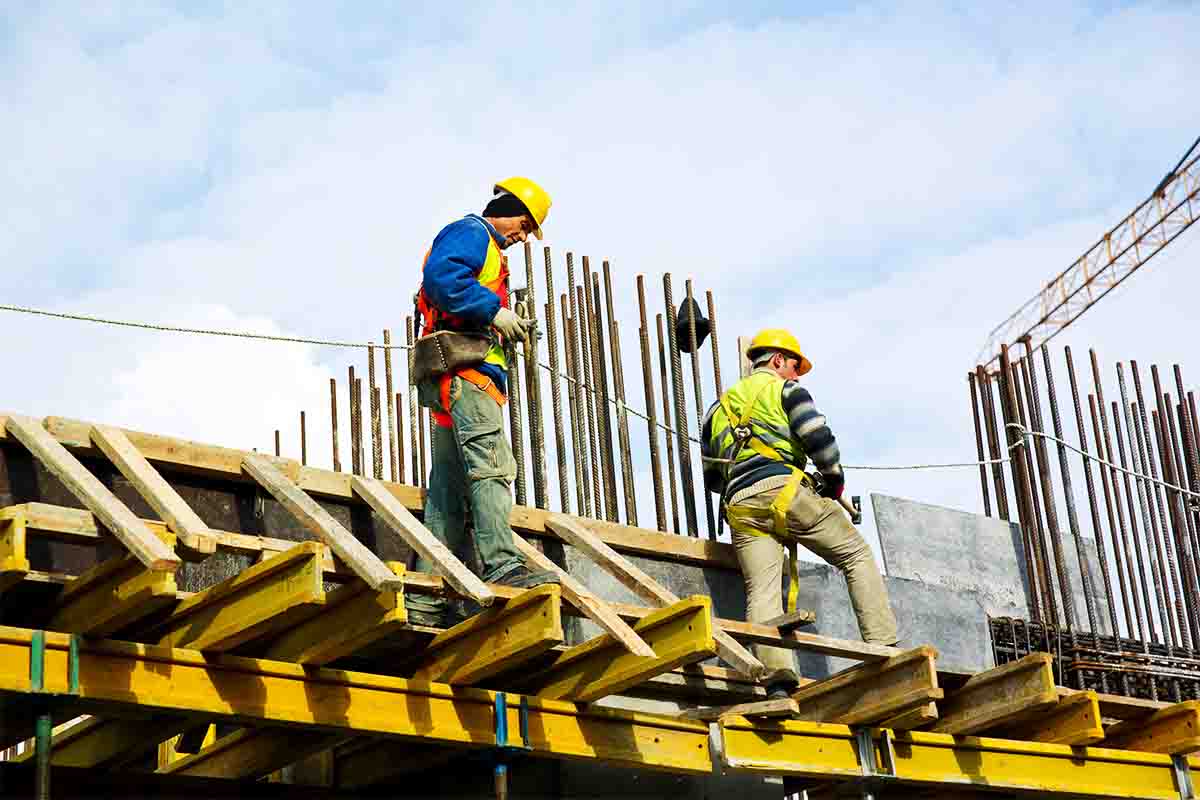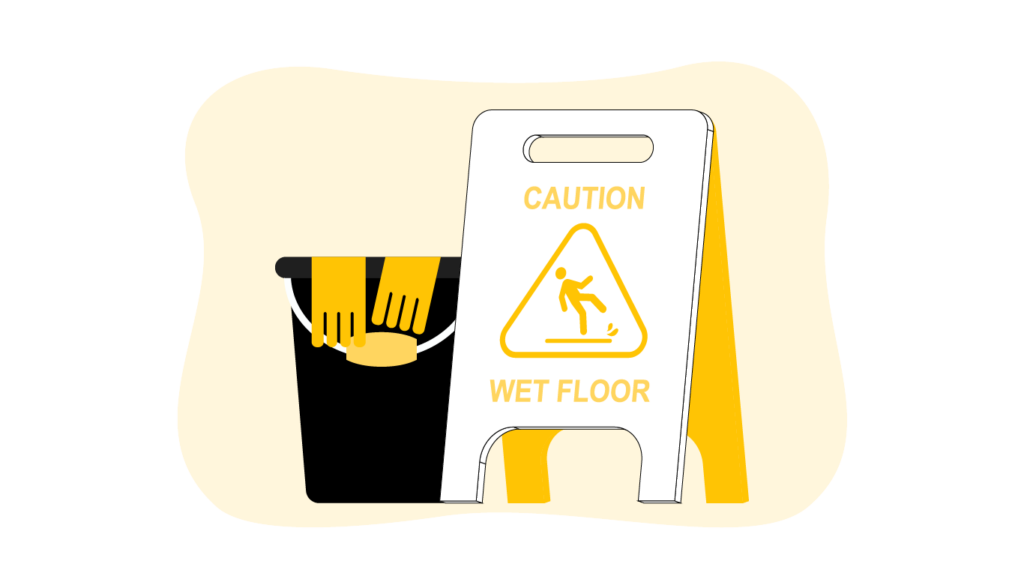How To Prevent Slips, Trips, And Falls

Nobody ever thinks that they will be the ones to slip, trip, or fall. Everything is going smooth until it’s not. The construction industry accounted for just less than 50 percent of all fatal falls, slips, and trips in 2020.
Unfortunately, this is not as surprising of a statistic as it should be. You might think that with the inherent risks of the trades, we should expect there to be such incidents. But slip, trip, and fall injuries are preventable.
Nothing will slow your work down more than a workplace injury. So, let’s see how we can contribute to the prevention of slips, trips, and falls.

“Prevent falls and slips, or you’ll have a hospital trip.”
Why Toolbox Talks & Safety Is Important
OSHA and other organizations encourage daily toolbox talks that give statistics and produce general awareness about workplace safety hazards. Sharing statistics and experiences like those mentioned above can be beneficial in increasing awareness so that you can prevent workplace injuries or death.
Reminders can help workers to be more cautious and aware of fixing problems before they happen and prevent accidents in general. An example toolbox talk template can be seen below.
OSHA Regulations & Standards for Slips, Trips, and Falls Hazards
An understanding of OSHA regulations can help us to be aware of data-driven safety measures that should be put in place to prevent injury and death. Relevant standards include:
- 1910 Subpart D – Walking-Working Surfaces,
- 1910.36 – Design and construction requirements for exit routes and
- 1910.37 – Maintenance, safeguards, and operational features for exit routes
However, beyond just giving rules, OSHA recommends implementing programs and procedures to mitigate risks, so we must establish a job site culture that expects everyone to follow those regulations.
- Poorly organized job sites can result in workers tripping over tools, materials, and trash. Bad housekeeping and failure to dispose of garbage or clear out debris and residue can also result in a compounding pile-up one day after the next, thus resulting in trip hazards. OSHA officers can perform random walkthroughs of job sites, and if they decide your housekeeping is not in order, they will fine the company.
- Falling from ladders is a real danger because of improper setup. OSHA 3150 mandates that you set up scaffolding and ladders on solid-level surfaces. You also might be in the bad habit of carrying items up and down an extension ladder, step ladders, or scaffolding. OSHA standards highlight that you should maintain 3 points of contact with your hands and feet. That means you can’t carry things up the ladder. It would be best if you instead used a roof derrick for more oversized items or a bucket and rope to hoist equipment and tools to upper levels.
- Utilizing fall protection is essential in preventing falls, which have the highest potential for extreme injuries and death. The construction industry has been able to choose the fall protection systems it uses on a case-by-case basis since the 1990s. In 2017, OSHA extended this freedom to general industry. In the construction industry, personal protective equipment such as harnesses and lanyards is expected to be worn at heights 6 feet and above. On open exposures that are 4 feet and higher, you should use guardrails and toeboards.
Slips, Trips, and Falls Hazards
To work towards the prevention of slips, trips, and falls, we need to understand what a safety hazard is.
Examples of safety hazards in the construction industry are the following:
- Uncovered cables on the floor
- Uneven surfaces
- Debris or waste caused by poor housekeeping
- Wet surfaces
- Ladders that haven’t been secured

Slips, Trips, and Falls Toolbox Talk Template
In order to prevent slips, trips, and falls, it is important to be aware of the hazards that can cause these types of accidents. Some common causes of slips, trips and falls on construction sites include:
- Wet or icy surfaces
- Uneven surfaces
- Poor lighting
- Loose debris
- Tools on the ground
- Unguarded openings
- Lack of proper fall prevention equipment
To avoid these hazards, take the following precautions:
- Wear appropriate shoes with slip-resistant soles
- Use caution when walking on wet or icy surfaces
- Make sure all walkways and stairs are well-lit
- Sweep up any loose debris or tools on the ground
- Use appropriate PPE
- Understand how to use PPE correctly and safely
Who is responsible for preventing slips, trips, and falls?
Everyone at work has a responsibility. The employer is ultimately responsible, but we should all look out for the well-being of ourselves and our colleagues.
We do this by learning and understanding instructions for PPE and for alerting colleagues to openings; by tidying away tools after use, and cleaning out workspaces. If you spot an issue relating to the weather or to lighting that is faulty, report it so that the company can fix it before it causes an accident.
How To Prevent Illnesses And Injuries Related To Slips and Falls
- Immediately clean up any spills, and demarcate any hazards—rope-off areas where there could be chemicals or other condensates. An injury could occur from hitting the ground due to a slip. Moreover, severe illness and death could result from slipping in corrosive or biohazardous materials.
- Cover holes and eliminate uneven surfaces that could have foot traffic. You could unknowingly trip and fall to the ground. If the hole is large enough, you could fall in, thus risking more than a minor injury.
- Provide proper lighting to ensure visibility so you don’t trip on what you cannot see.
- Use fall protection in the form of guardrails and personal protective equipment so that a person cannot fall over an open exposure, even accidentally. Falling from heights 4 feet and above puts you at serious risk of death.
- Establish a routine to inspect fall protection. It’s in place to save your life. You will want to make sure that it will work to protect you from injury or death.
Questions for the Employees
After a discussion, you may want to test everyone’s knowledge and retention of the information to apply what they’ve learned.
- What percent of workplace fatalities are from the construction industry?
- What are the potential causes of injury, and what could happen on your job site?
- How would you feel if an injury or death occurred on your job site?
- What can you personally do to prevent slip, trip, and fall incidents?
- What is our slips, trips, and falls safety talk slogan?
Email Template To Promote Slips, Trips, And Falls Safety
Sending a concise email can help to promote safety. Use this email template, which includes the highlights, and add more bullets as needed to address particular concerns for your job site.
Hello Team,
Let’s all be aware to prevent falls and slips, or someone will have a hospital trip.
The construction industry accounted for almost 50 percent of all fatal falls, slips, and trips in 2020.
Understanding our job site hazards and the ways we can mitigate risks is crucial to prevent us from being amongst those statistics.
- Remember to clean as you go and stay organized.
- Use handrails and ask for help when carrying big loads so that the extra hand is available to grab railings and you have full awareness of where you are walking.
- Use fall protection and PPE.
Increase your awareness as you are working. When you see a potential hazard, immediately report it and work to resolve it to prevent injury to yourself and others.
Thanks,
Construction Site Management/Foremen
Create A Safety Culture
You are now highly knowledgeable in the prevention of slips, trips, and falls. It is your responsibility to encourage your workers to increase awareness of potential hazards and processes for reporting. All incidents are preventable! Remember, you must “prevent falls and slips, or you’ll have a hospital trip.”


